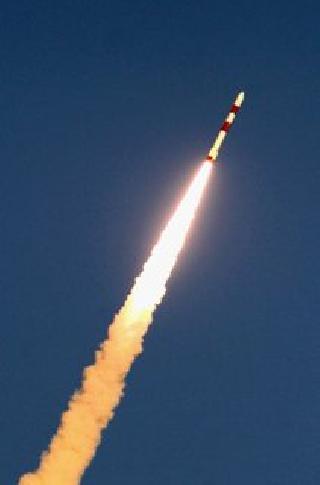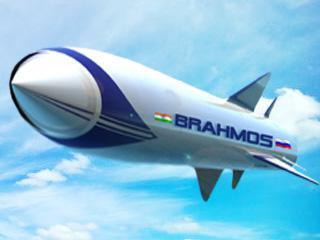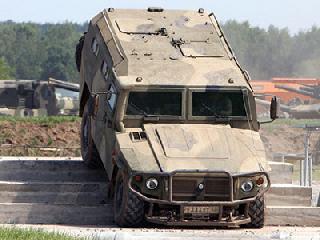
PSLV C-20/SARAL takes off during its launch from the Satish Dhawan Space Centre. Photo: PTI.
SRIHARIKOTA, AP (PTI): India's Polar rocket PSLV has successfully put into orbit seven satellites in the space of four minutes including an Indo-French oceanographic spacecraft that will study changes in the environment, completing its 22nd consecutive flawless launch.
After a textbook launch witnessed by President Pranab Mukherjee here on Monday, Indian Space Research Organisation's workhorse Polar Satellite Launch Vehicle(PSLV) placed into orbit in one single mission all the seven spacecraft--Indo-French oceanographic study satellite 'SARAL' and six foreign mini and micro satellites.
The PSLV-C20 rocket blasted off from the Satish Dhawan Space Centre in clear weather at 6.01 pm at the end of the 59-hour countdown, marking the 103rd mission of ISRO and yet another testimony to India's Space prowess. In 2008, India successfully launched 10 satellites in a single mission, boosting its capabilities in space.
The lift-off, scheduled for 5.56 pm, was delayed by five minutes to avoid probability of collision with space debris, a normal cautionary step in a launch mission, ISRO sources said.
Soaring into clear weather, the 44.4 metre tall 230-tonne rocket, in its core alone variant, injected the 409 kg Indo-French satellite SARAL first into orbit about 18 minutes after the lift-off, followed by six other foreign satellites in about four minutes as the scientists broke into cheers.
India has reaffirmed its commercial launch capabilities with Monday's launch of SARAL's co-passengers -- SAPPHIRE and NEOSSat (Canada), AAUSAT3 (Denmark), micro satellites BRITE and UniBRITE from Austria and STRaND from United Kingdom, with a combined weight of 259.5 kg.
Congratulating scientists for the 'remarkable launch' and 'meticulously executed' mission, Mukherjee said the success has reaffirmed PSLV's efficacy, accuracy and reliability.
Reflecting its successful run in commercial operations, Monday's launch took the total number of overseas spacecraft put into orbit by ISRO to 35.
PSLV yet again proved itself as a reliable robust rocket completing its 22nd consecutive successful launch in its 23 missions after the failure of the first one.
The SARAL-Altika satellite, a joint project of the space agencies of India and France, will complement the observations of the seas made by current satellites. It would be one of the very few ocean-centric satellites and a vital cog in studying sea surface heights and other aspects.
The ISRO-built SARAL is short for Satellite with ARgos and ALtiKa, the two main devices on it which have been provided by French space agency CNES. The two payloads have a mission life of five and three years respectively.
Besides building the spacecraft, ISRO will launch and operate it through its life giving a fillip to Indo-French space cooperation.
AltiKa is a Ka-band altimeter system, dedicated to accurate measurement of the rise in the sea levels.
The satellite would be useful in studying the sea state, light rainfall climatology, mean sea level and coastal altimetry.
It would help ocean scientists gather accurate data on the rise in the sea level which could threaten the low lying and coastal areas of the country.
The spacecraft will provide data products to operational and research user communities, in support of marine meteorology and sea state forecasting; operational oceanography; seasonal forecasting; climate monitoring; ocean, earth system and climate research, ISRO said.
Altimeter (Altika) would help study the sea surface heights while Argos is a satellite-based data collection platform.
SARAL, placed in orbit 785 km above the earth is the first mission under Indian Mini-Satellite (IMS) Bus series-2.
This platform, developed by ISRO, is aimed at carrying medium sized payloads useful for applications in areas of earth imaging, ocean and atmospheric studies.
ISRO had initially planned to launch SARAL on December 12 last year but deferred it to carry out additional tests to "address technical issues to ensure reliability".
Among the foreign satellites, the 74-kg NEOSSat (Near Earth Object Surveillance Satellite), built by Canada-based Microsat Systems, is aimed at detecting and tracking asteroids that might pose a threat to earth, reminded grimly by the recent strike of a meteor that streaked across the Russian skies.
The meteor had exploded with a force 30 times greater than the Hiroshima nuclear bomb, injuring around 1,200 people, bringing to focus the need to keep track of the innumerable of the near earth objects.
 Previous Article
Previous Article Next Article
Next Article













The Indian Air Force, in its flight trials evaluation report submitted before the Defence Ministry l..
view articleAn insight into the Medium Multi-Role Combat Aircraft competition...
view articleSky enthusiasts can now spot the International Space Station (ISS) commanded by Indian-American astr..
view article